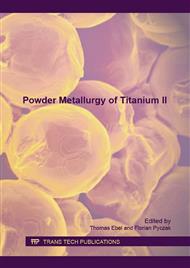[1]
A.M. Imam, F.H. Froes, R.G. Reddy, Cost effective developments for fabrication of titanium components, Key Eng. Mat. 551 (2013) 3-10.
DOI: 10.4028/www.scientific.net/kem.551.3
Google Scholar
[2]
I.M. Robertson, G.B. Schaffer, Review of densification of titanium based powder systems in press and sinter processing, Powder Metall. 53(2) (2010) 146-162.
DOI: 10.1179/174329009x434293
Google Scholar
[3]
Z.Z. Fang, Powder metallurgy titanium – challenges and opportunities, Int. J. Powder Metall. 46 (2010) 9-10.
Google Scholar
[4]
I.M. Robertson, G.B. Schaffer, Comparison of sintering of titanium and titanium hydride powders, Powder Metall. 53(1) (2010) 12-19.
DOI: 10.1179/003258909x12450768327063
Google Scholar
[5]
C.G. McCracken, D.P. Barbis, R.C. Deeter, Key characteristics of hydride-dehydride titanium powder, Powder Metall. 54(3) (2011) 180-183.
DOI: 10.1179/174329011x13045076771849
Google Scholar
[6]
T. Mimoto, N. Nakanishi, T. Threrujirapapong, J. Umeda, K. Kondoh, Cost effective and eco-friendly process for preparation of wrought pure Ti material via direct consolidation of TiH2 powders in Supplemental Proceedings: Materials Processing and Interfaces, v. 1 (ed TMS), 879-886, John Wiley & Sons, Inc., Hoboken, NJ, USA, (2012).
DOI: 10.1002/9781118356074.ch110
Google Scholar
[7]
O.M. Ivasishin, D. Eylon, V.I. Bondarchuk, D.G. Savvakin, Diffusion during Powder Metallurgy Synthesis of Titanium Alloys, Defect Diffus. Forum 277 (2008) 177-185.
DOI: 10.4028/www.scientific.net/ddf.277.177
Google Scholar
[8]
S.J. Gerdemann, P.D. Jablonski, Compaction of titanium powders, Metall. Mater. Trans. A 42A (2011) 1325-1333.
DOI: 10.1007/s11661-010-0520-z
Google Scholar
[9]
I.M. Robertson, G.B. Schaffer, Some effects of particle size on the sintering of titanium and a master sintering curve model, Metall. Mater. Trans. A 40A (2009) 1968-(1979).
DOI: 10.1007/s11661-009-9894-1
Google Scholar
[10]
O.M. Ivasishin, D.G. Savvakin, F.H. Froes, V.C. Moxson, K.A. Bondareva, Synthesis of alloy Ti-6Al-4V with low residual porosity by a powder metallurgy method, Powder Metall. Met. C+ 41 (2002) 382-390.
DOI: 10.1023/a:1021117126537
Google Scholar
[11]
H. -W. Liu, D.P. Bishop, K.P. Plucknett, Effect of processing variables on production of powder metallurgical titanium, Can. Metall. Quart. 52(1) (2013) 39-50.
DOI: 10.1179/1879139512y.0000000040
Google Scholar
[12]
E. Baril, L.P. Lefebvre, Y. Thomas, Interstitial Elements in titanium powder metallurgy: sources and control, Powder Metall. 54 (2011) 183-187.
DOI: 10.1179/174329011x13045076771759
Google Scholar
[13]
M.J. Donachie, Titanium: a technical guide, second edition, ASM International, (2000).
Google Scholar
[14]
S.L.G. Petroni, M.S.M. Paula, V.A.R. Henriques, Interstitial elements in Ti-13Nb-13Zr alloy produced by powder metallurgy using hydride powders, Powder Metall. 56(3) (2013) 202-207.
DOI: 10.1179/1743290112y.0000000046
Google Scholar
[15]
Standard Specification for Titanium and Titanium Alloy Bars and Billets, ASTM B 348-13, ASTM International, Philadelphia, PA, (2013).
Google Scholar
[16]
J.S. Reed, Principles of ceramic processing, second ed. John Wiley & Sons, Inc., New York, NY, (1995).
Google Scholar
[17]
M.N. Rahaman, Ceramic Processing and Sintering, second edition, CRC Press, Taylor & Francis Group, Boca Raton, FL, (2003).
Google Scholar
[18]
L. Bolzoni, P.G. Esteban, E.M. Ruiz-Navas, E. Gordo, Influence of powder characteristics on sintering behavior and properties of PM Ti alloys produced from prealloyed powder and master alloy, Powder Metall. 54(4) (2011) 543-550.
DOI: 10.1179/003258910x12827272082623
Google Scholar
[19]
L.P. Lefebvre, E. Baril, Effect of oxygen concentration and distribution on the compression properties on titanium foams, Adv. Eng. Mater. 10(9) (2008) 868-876.
DOI: 10.1002/adem.200800122
Google Scholar
[20]
O.M. Ivasishin1, V.C. Moxson, Fundamentals of low cost titanium hydride powder metallurgy, Titanium USA 2014, September 21-24, 2014, Chicago, Illinois, USA.
DOI: 10.1016/b978-0-12-800054-0.00008-3
Google Scholar


